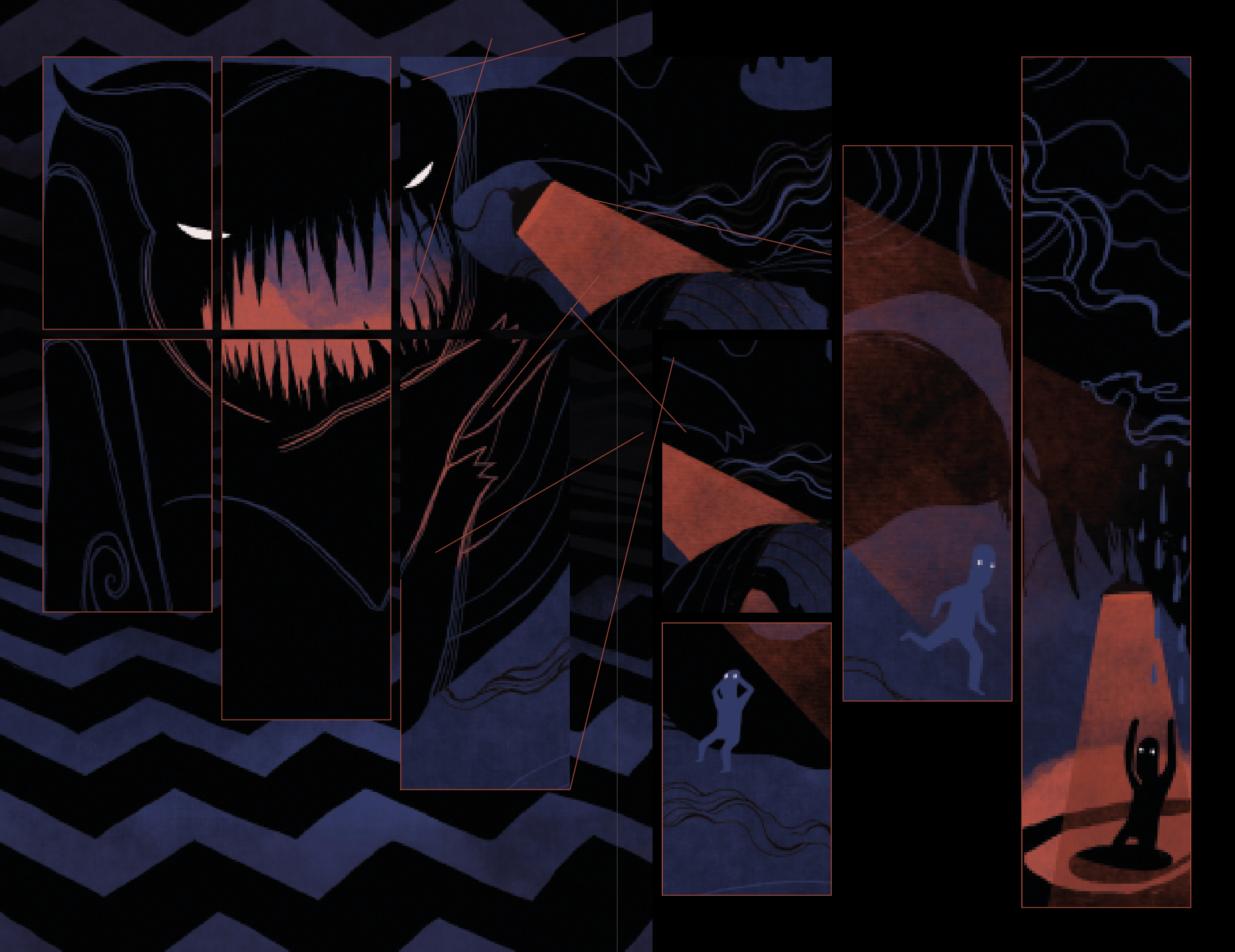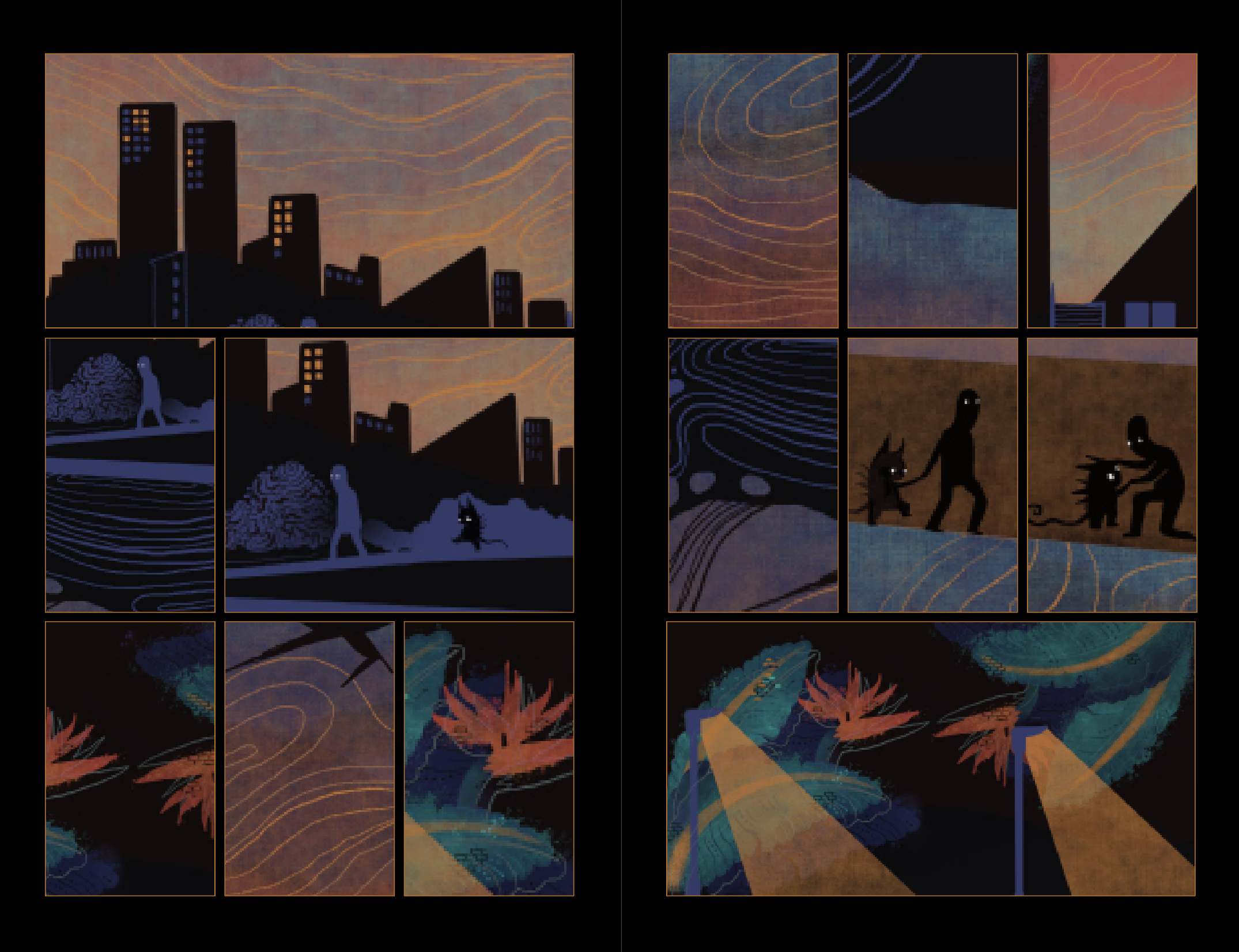Liminality
With Liminality, I endeavour to create an understanding of psychological liminal space and the transformative powers it has, through illustrating physical and fluid liminal spaces of which our characters are a part. There are no singular focal points within a page or double page spread as to do so would negate the atmosphere of liminality.





















The basic idea was this: a person goes about their daily life. It is boring, cyclic. They are then swallowed up and enter (what I am calling) the Innerworld. Here they sink, fight, cage, are chased by, swallowed by their monster (that symbolises depression). They must find a way out of the darkness and haul their monster up to Overworld. They then learn how to accept and live with their monster going forward. Although this may be a hard journey to take, I want it to be an uplifting one. People don’t usually escape the backrooms once they enter, or phase into liminal space.
Liminal spaces evoke a state of uneasiness, as they are a limbo, a threshold between the familiar and the unknown. Empty universes that seem to exist outside of time and space, liminal spaces can be unsettling, so the idea of being trapped in one can be quietly terrifying: a building psychological terror. Perhaps this is best explained by the root word līmin, Latin, meaning threshold. The emptiness enveloped within a liminal space leaves you isolated, alone, with an eerie prickling radiating across your insides.
“It’s just strange. One day someone’s just walking around, going to work, alive and then… nothing. People just disappear”
- American Psycho
The back rooms were built upon this premise, and a thread grew on 4chan/reddit/creepypasta. The idea was that you would accidentally stumble upon these backrooms, like a glitch, a secret hidden area of your landscape. Yet once you entered, leaving would be nearly impossible. This reflects back to psychological liminal space, as once you begin to spiral, it is hard to stop. To find your way out of the pit of despair is crucial, yet accomplishing this is arduous.
Physical liminal spaces are expressed by the removal of people, objects and signs of life from ordinary places, retaining only human-made constructs. This establishes the “uncanny”, an eerie feeling from viewing your world in a familiar but strange new way, proposing an alternative reality beyond our awareness, something that’s beyond our control.
I have noticed some explanations of liminal space to include the words Kenopsia and Anemoia, attributing them to Greek.
However, I was informed by a Greek, Editor friend of mine that:
“while they [Kenopsia/Anemoia] are Greek, I think they are modern words created by non-Greeks. Sometimes these words make their way back into Greek (like ‘utopia’), which is a rather fascinating linguistic journey, sort of like second or third-generation migrants from diasporic communities returning to their ancestral homelands.”
Although neither word is as genuine as I had first thought, the meanings associated with these still help us to understand what liminal space is.
Kenopsia describes a forlorn atmosphere of a place that should be coloured by the throng of people but is now abandoned. The Red Room, from David Lynch’s Twin Peaks, is a fantastic example of this; and is also known as The Waiting Room. The idea of waiting and not knowing what might be next, is common in the transitional nature of liminal spaces. This can add dread to the palette, as we wait in a void.
Anemoia is used as a nostalgia for a feeling you have never known. This is an example of a temporal liminal space, another would be one we are all familiar with: the pandemic.
The pandemic has felt like our very own isolated dystopian liminality and has left a mark on us all. It has had a huge impact on my work and during this liminal space in my life, I created Isolation Monster.
The idea of Isolation Monster has evolved to the acceptance of mental illnesses, that at the end of the grief cycle, acceptance is key to endurance. Our mental illnesses are a part of us, and may hurt us, but they are not us. We aren’t defined by them.
Psychological liminal spaces are areas of transition. These are very personal as everyone has had different experiences, this will echo in the feelings you may perceive while viewing the same image, or reading the same story. To create a liminality that is a blanket for many is therefore challenging, ambitious but also crucial to communicate the ambience and ideas throughout this transformative journey.
I aspire to envelop all three types of liminal space within Liminality: physical, psychological and temporal. This is an experiment,
a conceptual silent graphic novel with
life as a liminal space.

